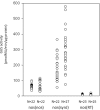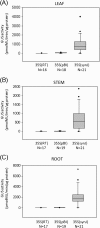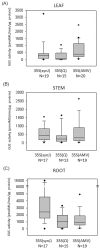A 28 nt long synthetic 5'UTR (synJ) as an enhancer of transgene expression in dicotyledonous plants
- PMID: 23140609
- PMCID: PMC3536603
- DOI: 10.1186/1472-6750-12-85
A 28 nt long synthetic 5'UTR (synJ) as an enhancer of transgene expression in dicotyledonous plants
Abstract
Background: A high level of transgene expression is required, in several applications of transgenic technology. While use of strong promoters has been the main focus in such instances, 5'UTRs have also been shown to enhance transgene expression. Here, we present a 28 nt long synthetic 5'UTR (synJ), which enhances gene expression in tobacco and cotton.
Results: The influence of synJ on transgene expression was studied in callus cultures of cotton and different tissues of transgenic tobacco plants. The study was based on comparing the expression of reporter gene gus and gfp, with and without synJ as its 5'UTR. Mutations in synJ were also analyzed to identify the region important for enhancement. synJ, enhances gene expression by 10 to 50 fold in tobacco and cotton depending upon the tissue studied. This finding is based on the experiments comparing the expression of gus gene, encoding the synJ as 5'UTR under the control of 35S promoter with expression cassettes based on vectors like pBI121 or pRT100. Further, the enhancement was in most cases equivalent to that observed with the viral leader sequences known to enhance translation like Ω and AMV. In case of transformed cotton callus as well as in the roots of tobacco transgenic plants, the up-regulation mediated by synJ was much higher than that observed in the presence of both Ω as well as AMV. The enhancement mediated by synJ was found to be at the post-transcriptional level. The study also demonstrates the importance of a 5'UTR in realizing the full potential of the promoter strength. synJ has been utilized to design four cloning vectors: pGEN01, pBGEN02, pBGEN02-hpt and pBGEN02-ALSdm each of which can be used for cloning the desired transgene and achieving high level of expression in the resulting transgenic plants.
Conclusions: synJ, a synthetic 5'UTR, can enhance transgene expression under a strong promoter like 35S as well as under a weak promoter like nos in dicotyledonous plants. synJ can be incorporated as the 5'UTR of transgenes, especially in cases where high levels of expression is required. A set of vectors has also been designed to facilitate this process.
Figures









References
-
- Samac DA, Tesfaye M, Dornbusch M, Saruul P, Temple SJ. A comparison of constitutive promoters for expression of transgenes in alfalfa (Medicago sativa) Transgenic Res. 2004;13(4):349–361. - PubMed
Publication types
MeSH terms
Substances
LinkOut - more resources
Full Text Sources
Other Literature Sources
Research Materials

